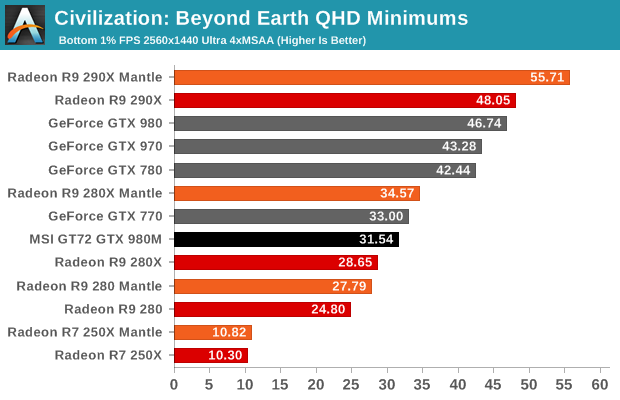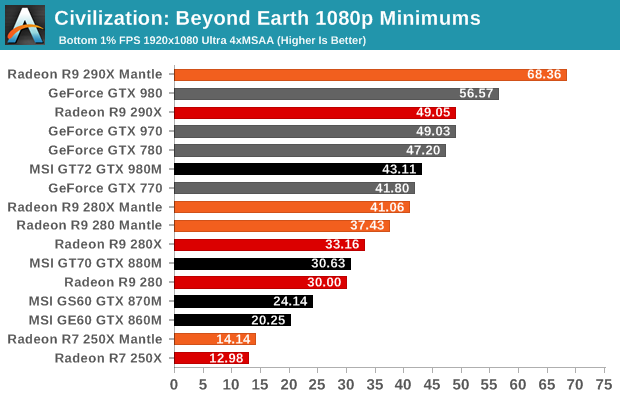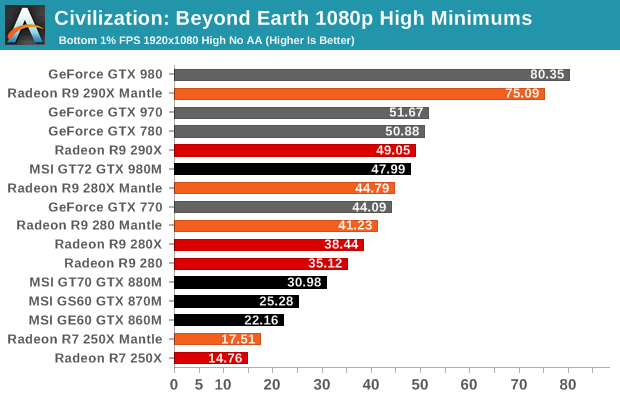Benchmarked - Civilization: Beyond Earth
by Jarred Walton on October 23, 2014 8:00 AM ESTCivilization: Beyond Earth Minimum Frame Rates
One of the requests I've received since initially posting this overview of performance was to investigate minimum frame rates. All of the necessary data was already available, but I just hadn't spent much time investigating the subject. It turns out the minimum frame rates end up being a bit more interesting when we get to the subject of Mantle.
Before we get to the charts, let me also explain one detail that can be important: I don't really care much about the pure minimum frame rate. If a game has to load a texture or some other hiccup causes a single frame dip to 10 FPS, but all of the remaining frames render at 90FPS over a two minute period, does that one dip matter much? I don't think so. To better show the impact of minimum frame rates, I've averaged the bottom 1% of all frames over the benchmark sequence. This makes the measurement much more significant, because if you're routinely seeing downward spikes in frame rates it can be distracting.
In the case of Civilization: Beyond Earth, I didn't notice any issues with inconsistent frame rates, so this "Lowest 1% FPS" measurement isn't quite so important, but in other games it can mean the difference between reporting 30FPS as the minimum and reporting 130FPS as the first percentile of frame rates. Basically, Civilization: Beyond Earth hits minimum FPS when you zoom all the way out, particularly when there are a lot of units on the screen, and that's exactly what happens in the benchmark at about the halfway point.
With that explanation out of the way, let's look at the charts:




One thing that immediately jumps out is that the improvements in minimum frame rates with Mantle tend to be even higher than the improvements in average frame rates. This is actually more or less what you would expect, particularly in this case where the minimum frame rates appear to be caused by CPU bottlenecks on the faster GPUs like the R9 290X. Lighten the CPU load with Mantle and that allows for frames to be generated more quickly in such cases.
Where average FPS only improved about 5-10% with Mantle, the improvements in minimum frame rates are much more noticeable. The lowly R7 250X sees the least benefit, which makes sense as it's almost totally GPU limited. The R7 250X still improves by 3-5% at our highest resolutions, and a more significant 9% increase at 1080p Ultra; but look at the 1080p High result: it's 19% faster on minimum frame rates. What's more, that 19% mark ends up being pretty tame in comparison to the improvements on the faster GPUs.
The R9 280 improves by 12-25%, with the biggest jump coming at 1080p Ultra. The R9 280X sees 17-24% improvements in minimum frame rates, again with the largest increase coming at 1080p Ultra. And then there's the R9 290X. Interestingly, it only sees a small 5% improvement at 4K Ultra, but at QHD it gets a 16% bump; at 1080p Ultra and High settings, Mantle really frees up some additional performance and the minimum frame rates increase by 39% and 53%!
Moving to the AMD vs. NVIDIA side of things, the R9 290X actually manages to come out ahead of the GTX 980 (though just barely) at 4K and QHD resolutions. The margin of victory for AMD is also quite pronounced at QHD, where it leads by a not insignificant 19% with Mantle enabled (but only 3% with DX11). The R9 280X tells a similar story, where it loses to the GTX 770 by a sometimes large margin using the DX11 path, but Mantle closes the gap and often gives the 280X a lead over the 770.
Looking quickly at the laptops, the GTX 980M continues to be a force to be reckoned with, delivering performance generally slightly above that of the GTX 770 and R9 280X, particularly at the GT72's native 1080p resolution. The GTX 880M also manages to stay above 30FPS in our testing, but the 870M and 860M drop into the low to mid 20s. That said, Civilization: Beyond Earth remains playable even at slightly lower frame rates, as the turn-based nature doesn't generally require fast responses and the mouse input is already decoupled from the rendering pipeline.










72 Comments
View All Comments
JarredWalton - Thursday, October 23, 2014 - link
It's a $330 CPU running up to what was once $1100 worth of GPU (2 x R9 290X). It's more CPU than a lot of people have, but OC i7-4770K isn't much faster than an overclocked i5-4670K that only costs $220. Most gamers have something roughly at the level of the i5-4670K is my feeling; if they don't, then they probably don't have an R9 or GTX graphics card either. :-)(And yes, there are always exceptions, but we're talking big picture here.)
Kalelovil - Thursday, October 23, 2014 - link
That assumes that people are building their PCs today.There a plenty of people still with i7-2500k/FX-8320 era CPUs and mid-high end GPUs who are interested in effects of Mantle on game performance.
Artuk - Friday, October 24, 2014 - link
That would be me. I am running on an FX-4100 OC to 4Ghz. My R9 280X is my "tock". I will tick again when windows 10 comes out and get a new CPU etc.I think a lot of us with 1 GB video cards found ourselves upgrading with the latest set of games hungry for more texture memory even if everything else was "acceptable".
My hope is that mantle will mitigate the sub-par processor a bit.
Artuk - Saturday, October 25, 2014 - link
My informal benchmark with the FX-4100 and the R9 280X was that mantle provided a significant benefit on the part of the bench at the end where it pans out. The scrolling was smoother and I was seeing 30 fps with mantle. With DX11 the scrolling struggled and I was in the teens a few times. Generally Mantle was showing a 25% increase in the extreme cases.In the earlier part of the bench where it is a little more zoomed in I saw the same moderate 5fps or so difference that others are seeing.
YMMV
limitedaccess - Thursday, October 23, 2014 - link
Is it possible to test the performance and playability with IGPs, particularly at 1080p (but lower settings)?If Beyond Earth retains the touch controls from Civ 5, then it would be a rather suitable game for hybrids/convertibles (eg. Surface Pro).
JarredWalton - Thursday, October 23, 2014 - link
I can add a bit of testing today on IGP and see how that goes... stay tuned.garbagedisposal - Friday, October 24, 2014 - link
Also interested in this, thanks for testing.Stuka87 - Thursday, October 23, 2014 - link
Mantle needs to be tested with a slower GPU to really shine. Testing it with one of the fastest CPU's out is not really the best test for Mantle.Running the same test with a slower CPU (say 2-3 years old) should show a bigger jump.
limitedaccess - Thursday, October 23, 2014 - link
Did you (and is it possible) to test whether or not Mantle has an impact on turn times (for AI calculations) if it does reduce CPU overhead for rendering?SviGG - Thursday, October 23, 2014 - link
Exactly what I'd like to see! Civ has always been a cpu bound game, especially toward the endgame. Try playing a large map with 8-12 civs in the modern age. You can go make a coffee between each turn, makes it nearly unplayable. With mantle's biggest benefit being cpu limited scenarios, which so far has meant pairing a highend gpu with a low end cpu, I'd like to see what kind of impact it has on turn times. I've been waiting to see those kinds of test since they announced Beyond earth would be supporting mantle. I'd be interesting to see what it can do with some high end cpu's when the game can actually push them.